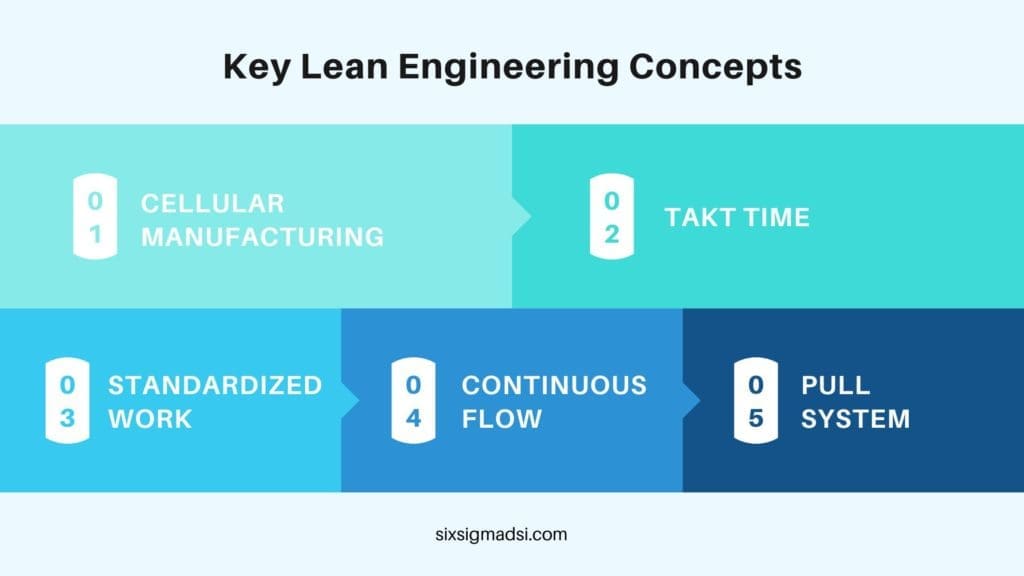Table of contents
LEAN Engineering, What is it?
Lean engineering is a way to increase the efficiency and effectiveness of engineering operations departments within a manufacturing factory methods. It can also help them become more innovative and competitive while optimizing their resource efficiency and saving money. This article will discuss some of the fundamental principles and practices of Lean Engineering and lean management system definition.
LEAN Engineering is a philosophy that focuses on people and helps to improve and optimize production systems. It identifies and eliminates all “waste” which are processes or activities that consume more resources than necessary.
Identify the following types of “waste” in production: transportation, overproduction, excessive processing, inventory movement, and time waiting. LEAN identifies what we shouldn’t be doing, as it doesn’t add value to our client and tends to eliminate it.
It employs a comprehensive set of techniques to achieve its goals. These include quality management, organization of jobs, internal flow of production, maintenance, and management of the supply chain. LEAN implementation has many benefits that can be demonstrated.
The ultimate goal of LEAN manufacturing methods is to create a new CULTURE for improvement that is based on communication and teamwork. It is important to adapt the method to each case. LEAN is a philosophy that doesn’t take anything for granted. It seeks out new ways to do things in an agile, flexible, and economical way.
What is Lean Engineering?
LEAN Engineering is neither a static concept that can be easily defined nor a radical philosophy that breaks with all the known. Its uniqueness lies in the combination of various elements, techniques, and applications that result from the study of the foot machine. This is supported by management who are fully aware of their needs. LEAN thinking is a permanent result.
Lean engineering influences engineering in a holistic way.
- Leadership principles and practices in engineering organizations
- Teams
- Process visualization and team processes
- Technology and tools used to optimize efficiency
- Management and creation of engineering intelligence
- Lean engineering is a way to reduce waste and create more value for customers.
Determining Waste
It is easy to spot waste in lean manufacturing methods. Products move from one stage to another until they are finished. You only need to look for evidence of bottlenecks or blockers.
What is waste in engineering? Where the majority of the product is hidden within the heads of employees? In Lean engineering, waste is any activity, process, or product that doesn’t add value to customers. There are many ways to generate waste in engineering.
- Overproduction: Making reports, tests, and other unnecessary analyses
- Inventory: Incomplete analyses, reports, or tests
- Transportation: Handoffs and complex validations of decisions.
- Unnecessary movement
- Waiting: To receive inputs, decisions, or feedback
- Defects: Work that is not required or approved; mistakes in attempting to fix the problem
- Overprocessing: Unnecessary tasks, activities, and processes, especially for communication and analysis; “reinventing” the wheel with every new task
- Potential for untapped employee potential: Engineers are not encouraged to participate in process improvements for engineering
Lean principles can be applied to engineering to reduce uncertainty, increase productivity, and provide a method for improving process performance.
Key Lean Engineering Concepts

Cellular manufacturing
Lean engineering companies often use cellular manufacturing. Cellular manufacturing is designed to allow teams to work as efficiently and quickly as possible. This helps to reduce cycle times and inventory, which in turn allows for faster market response times.
Cellular manufacturing is based on “cells”, which are composed of one or more machines that accomplish a particular task. The manufacturing process involves products moving from one cell to another.
This arrangement allows maximum flexibility. Machines are mostly automated, so engineering changes can be made quickly, whether it’s minor tweaks or complete design overhauls.
Takt time
Takt time refers to the amount of production required to meet customer demand. It’s the time taken between one unit being produced and the next. This is adjusted to meet customer demand. Lean engineering organization’s management system definition can use additional resources or demand leveling to fix problems in manufacturing lines or processes.
Standardized work
Lean engineering organizations can improve the efficiency of their operations, communicate better, and share knowledge across the organization by implementing a system for standard work. To increase innovation and efficiency within the organization, methods, materials, tools, and processes can all be standardized.
Continuous flow (limiting WIP)
Lean engineering organizations use it to ensure operations continuous flow. This Lean concept is called limiting WIP or work-in-process. Any piece of work that is actively being done is considered to be part of the work-in-process.
Continuous flow encourages the Lean engineering factory to stop starting and instead finish work. This could be knowledge work or products on an assembly-line line.
Pull system
A pull system is closely related to continuous flow. Usually visualized Most often, work is entered into the system by a customer request, such as ordering a product.
A pull system encourages teams to prioritize work and complete it as needed. This is different from a push system in which work begins without considering existing WIP. This can lead to a WIP overload, which will slow down productivity.

The 5 Whys
The 5 Whys Lean Engineering method of root cause analysis encourages exploration and data-driven problem-solving. It is very simple. You start with a problem statement and then ask “Why?” until you find the right answers. Problem Statement: Our QA process causes a bottleneck in the system. This slows down downstream and upstream progress. The “5” part in the 5 Whys is just a suggestion. You might be able to find the root cause of your problem with 3-7 whys. The 5 Whys are used by Lean Engineering organizations to find the root causes of any problems that hinder efficiency, flow, or speed.
PDCA
The PDCA Cycle is a logical way to solve problems. It is the next step in problem-solving after the 5 Whys. PDCA stands as:
Make a plan. You should include success criteria and expected results.
Follow the plan.
Measure the results and analyze them. Compare the results with what you had hoped for and consider any discrepancies.
Make the necessary adjustments to reach your goal
The PDCA cycle is a helpful way for Lean engineering organizations to practice.
What other ways can LEAN Engineering be used?
Mention them in the comments below.



















